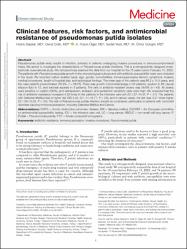| dc.description.abstract | Pseudomonas putida rarely results in infection, primarily in patients undergoing invasive procedures or immunocompromised hosts. We aimed to investigate the characteristics of Pseudomonas putida infections. This is a retrospectively designed cross-sectional observational study. We retrospectively scanned the data from our hospital for the 10 years before February 15, 2022. The patients with Pseudomonas putida growth in the microbiological cultures and with antibiotic susceptibility tests were included in the study. We recorded culture isolates types, age, gender, comorbidities, immunosuppressive factors, symptoms, invasive medical procedures, length of hospital stay, and radiological findings. The mean age of the patients was 66.2 ± 14.5 years, and the male patients predominated (76.3%, n = 58/76). There was growth in bronchial lavage in 33 patients, sputum in 28, pleural effusion fluid in 12, and tracheal aspirate in 3 patients. The rate of antibiotic-resistant strains was 56.6% (n = 43). All strains were sensitive to colistin (100%), and carbapenem, amikacin, and gentamicin sensitivity rates were high. We observed that the risk of antibiotic resistance increased 4.29 times in the patients in the intensive care unit (Cl:1.27–14.47, P = .01). The patients with Diabetes Mellitus had a higher risk (OR 4.33, Cl:1.11–16.77, P = .03), and in cancer cases, the risk was 3.31 times higher (Cl:1.06–10.32, P = .03). The risk of Pseudomonas putida infection should be considered, particularly in patients with comorbid disorders causing immunosuppression, including Diabetes Mellitus and Cancer. | en_US |


















